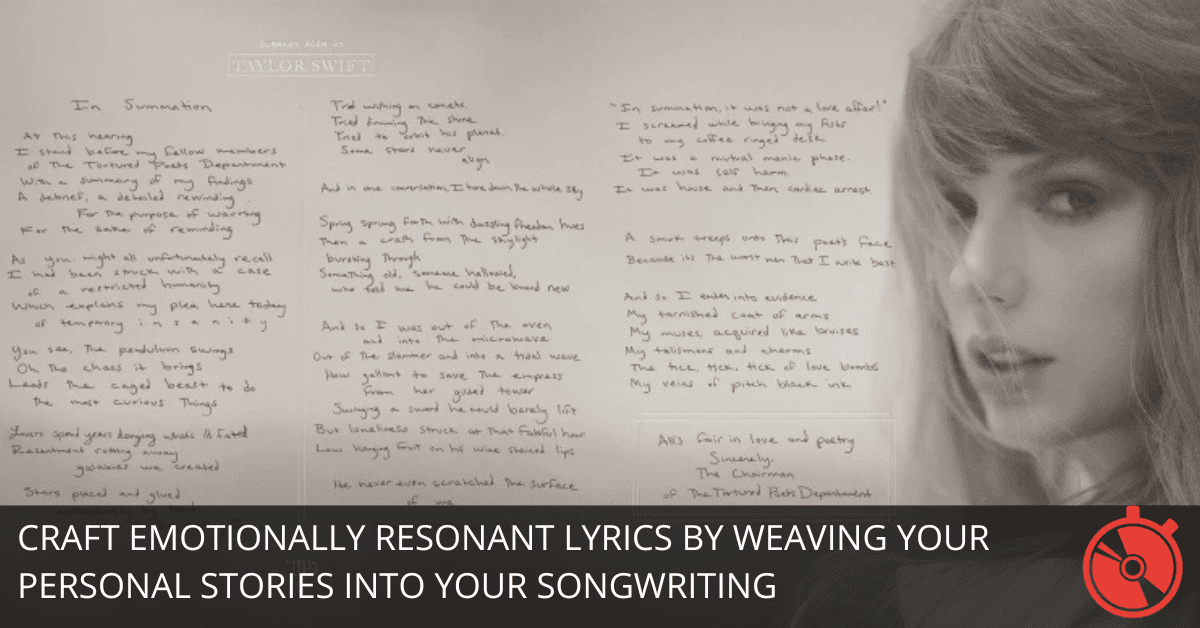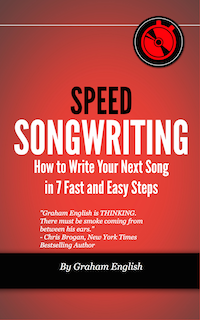
If you're an aspiring songwriter, you've probably heard it before: write what you know.
No one does this better than Taylor Swift. She has turned personal experiences into hit songs for over a decade.
So, how can you take your own life stories and transform them into lyrics that connect with listeners? Let’s break it down, step by step, so you can start writing songs that resonate just as much as Taylor’s.
1. Identify Specific Moments from Your Life
Taylor Swift doesn’t just write about “love” or “heartbreak” in general terms. She zooms in on specific moments — the time she danced in a refrigerator light (“All Too Well”) or when she was 15 and realized first love wasn’t forever (“Fifteen”).
These details are what make her songs relatable. People don’t just want to hear about emotions; they want to experience them through the little moments that trigger those feelings.
Here’s what to do: think about a vivid moment in your life that stirred up a strong emotion. It doesn’t have to be dramatic — it could be as simple as sitting in your car after a long day or the smell of your ex’s jacket. Write down everything you remember about that moment: the sights, sounds, smells, and, most importantly, the emotions it stirred in you.
2. Use Concrete, Specific Language
One reason Taylor’s lyrics hit hard is because they’re specific. In “You Belong with Me,” she doesn’t just say, “I don’t fit in” — she sings about wearing “sneakers” while the other girl wears “high heels.”
This level of detail paints a picture for the listener, pulling them into the story. You don’t need a lot of adjectives or fancy words to achieve this; you need specific, relatable images.
Here’s a trick: replace any abstract words in your draft (love, fear, sadness) with concrete nouns or actions. Instead of writing, “I felt lonely,” write something like, “I stared at the empty side of the bed.” This instantly turns a vague feeling into a vivid scene. Go through your lyrics and swap out any generic terms with something more precise.
3. Show, Don’t Tell
Ever notice how Taylor Swift rarely just says how she feels? She shows it through actions and imagery.
In “All Too Well,” she could have said, “I’m sad we broke up,” but instead, she sings, “I left my scarf there at your sister’s house.” That scarf becomes a symbol for the entire relationship. Using symbols and small actions to represent larger emotions is one of her signature techniques.
To apply this, choose one object, action, or setting that represents the emotion you want to convey in your song. Maybe it’s a broken coffee mug, the quiet after an argument, or the sound of your shoes on a rainy sidewalk. Use this detail to carry the weight of the emotion without directly saying it.
4. Start with a Strong Opening Line
One of the things Taylor does brilliantly is starting her songs with a bang.
The first line of “We Are Never Ever Getting Back Together” is: “I remember when we broke up the first time.” Instantly, you’re pulled into the story. The lesson? Don’t waste time with vague intros or too much buildup.
When you’re writing, aim to capture attention from the very first line. Think about the strongest part of your memory and start there. For example, if you’re writing about a breakup, don’t start with “It’s over.” Instead, go for something specific like, “You left the keys on the table, said nothing, and walked out.” This kind of detail grabs attention and gives the listener a reason to keep listening.
5. Write in First Person, Present Tense
Taylor Swift often writes in first person, which immediately puts the listener in her shoes. It’s direct, personal, and engaging. Songs like “Blank Space” or “All Too Well” draw you in because you feel like you’re right there with her, experiencing every twist of the story.
Try switching your song to the first-person perspective, especially if you’ve written it in third-person or past tense. First-person makes the lyrics feel intimate and raw, allowing listeners to connect with the narrative on a deeper level. Don’t just tell the listener what happened; bring them into the moment with you.
Bonus Writing Prompt #1: Write a Song from a Single Memory
Think of a memory where you felt a strong emotion—anger, love, disappointment, joy. Close your eyes and focus on the physical details of that moment. What were you doing? What could you see? What could you hear? Let these details form the backbone of your song. Here’s a quick outline to get you started:
- Opening Line: Choose the most powerful, striking detail from that moment and turn it into your opening line.
- Verse 1: Describe the scene using concrete, specific language. Bring the listener into that moment with you.
- Chorus: Use the chorus to summarize how this moment made you feel, but avoid using abstract words like "sad" or "happy." Instead, show your emotion through a concrete image or action.
- Verse 2: Add another layer to the story. Maybe the memory shifts, or you reflect on how it has affected you now. Use the same detailed approach.
Bonus Writing Prompt #2: Turn an Object into a Symbol
Think of an object that reminds you of someone or something important — like Taylor Swift’s scarf in “All Too Well.” It could be a letter, a song, a piece of clothing, or even something as simple as a coffee cup. Use that object as the central metaphor for your song. Here’s how:
- Opening Line: Introduce the object. For example, “The cracked mug sat on the counter, filled with cold coffee.”
- Verses: Use the object to tell the story of what happened. Every verse should add more depth — why this object matters, what it represents, and how it connects to the emotion you’re feeling.
- Chorus: Let the chorus explore the bigger meaning of the object. Why does it still linger in your memory? How does it relate to the relationship or moment you’re writing about?
Final Thoughts
Writing personal lyrics like Taylor Swift isn’t about oversharing; it’s about capturing specific moments and emotions that resonate with listeners. You can create songs that feel real and relatable by focusing on vivid, concrete details and using your personal experiences.
Start small. Write about the last time you felt joy, heartbreak, or nostalgia. Use these steps to translate your feelings into lyrics that not only tell a story but also connect with others.

Enter your first name and email address below and click “GET ACCESS NOW!” to get the Speed Songwriting Cheat Sheet delivered to your inbox!
We guarantee 100% privacy. Your information will not be shared.

Leave a Reply